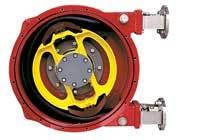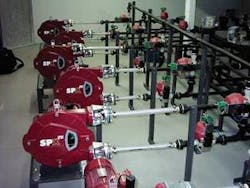Hose Pumps Provide Option for Abrasive Municipal Applications
By Chuck Treutel
Originally conceived as a cement pump, the hose pump is gaining acceptance for transferring and metering abrasive fluids in many industries.
In 1971, engineers at Holland-based Bredel (now Watson-Marlow Bredel Pumps) were busy developing a machine to spray a cement mixture. When the time came to put a positive displacement pump in the new device to move the concrete, company engineers were underwhelmed by the choices in the marketplace. Consequently, the decision was made to create a brand new pump - one that could pump concrete through the machine and also tolerate the material’s abrasive properties.
The pump they developed worked so well, it spawned new research and development at Bredel. It was not long before the hose pump transformed from a purpose-built cement pump into the technology it is today - a worldwide solution for pumping abrasive fluids.
Hose pumps are unique in that there are no seals, valves, or moving parts in the product stream, making the pump ideal for abrasive slurries. The pump’s operation is simple: a hose element positioned in a stationary pump housing is compressed from the outside by shoes that are mounted to a rotor. Fluid is pushed toward the discharge as the rotor slides the shoes along the hose while the restitution of the hose behind the shoe allows more fluid to be drawn into the pump. This design means the abrasive fluid is completely contained within the hose; the rotor remains outside the pumpage zone and never actually touches the product being moved. The complete closure of the hose element gives the pump its positive displacement action, preventing flow drop or erosion from backflow and also eliminating the need for check-valves.
A hose element has a serviceable life before fatigue requires replacement -- it is predominantly dependent on the pump speed and compression forces on the hose, but not influenced by the abrasiveness of the fluid that is pumped. With pumps that can deliver a range of 0.005 - 400 gpm and 0-240 psi discharge pressure, hose pump manufacturers will typically size pumps to run at speeds to deliver thousands of hours of hose life. Manufacturers of high quality pumps machine their hoses to maintain tight tolerances and use adjustable shoes to set the perfect compression force for specific process conditions. Such steps optimize hose longevity, maintain flow stability over the life of the hose, eliminate the potential for abrasion wear from slip and ensure repeatable performance from hose to hose.
Cost of Ownership
The contrast in maintenance and installation simplicity versus other positive displacement pumps shows why hose pumps can offer the lowest cost of ownership in abrasive applications.
While initial capital cost of a hose pump can be higher than other positive displacement pumps (a typical hose pump may cost about $14,000, while a progressive cavity of equal capacity costs $12,000), the subsequent costs associated with repair, downtime, and ancillary items can tip the life cycle cost calculation in favor of the hose pump.
Hose element replacement on the largest hose pump models takes about one hour and is performed at the installation site. To replace a hose element, simply remove the flanges from the pump and jog the motor to expel the old hose and feed in a new one. Replacement hose element costs are approximately 5% of initial pump price, compared with progressive cavity pumps where rotors, stators, gear joints and connecting rods cost 75% of the pump’s initial price and are laborious to replace.
Peristaltic pumps also do not require the ancillary equipment commonly used with a progressive cavity pump in abrasive applications, such as double mechanical seals, seal water flush systems, run dry protection systems (hose pumps can run dry without damage) and in-line check valves. For ancillary equipment, a hose pump may require a pulsation dampener in installations with long pipe runs and very high fluid velocities; however, normally, pulsation is eliminated without a dampener through minor pipe changes or use of flexible lines.
Abrasive Applications
In the environmental market, there is a myriad of abrasive fluid applications such as gritty sludge for which hose pumps are ideal. Because hose pumps have a non-slip positive displacement design, they give repeatable flow per revolution along their entire speed range regardless of discharge pressure. This makes them excellent metering pumps, though they are commonly applied in fixed speed transfer applications as well. In slurry applications, hose pumps are fully reversible, self priming, and can run dry without damage. The pumps also add the benefit of being able to blow out blockages or drain process lines of high settling solids. Perhaps the most common hose pump application is moving hard-to-handle lime slurry, which is used for acid neutralization and biosolids stabilization in wastewater treatment plants.
For moving thickened, solid-laden sludge - as in thickener underflow - market sectors like wastewater treatment regularly select hose pumps. The pumps are also used to feed solid-liquid separation and filtration equipment like belt filter presses, plate and frame filter presses and centrifuges. Potable water treatment plants use hose pumps to meter sand-like, powder-activated carbon (PAC) used to purify water.
Other Uses
Hose pump usage is not limited to abrasive applications. The low operating speeds of a hose pump make them a regular selection for liquid polymers. The ability to pump mixed phase fluids efficiently and run dry make hose pumps ideal for draining tanks or pumping “off-gassing” fluids such as sodium hypochlorite or for pumping air-entrained DAF float and scum. Corrosive and caustic treatment chemicals like ferric chloride, alum, sodium hydroxide, potassium permanganate, sodium bisulfite, hydrofluosilicic acid, and sulfuric acid are also easy to handle, because there is no metallic contact − the fluid is contained within the hose element.
Despite all of these advantages, hose pumps represent a modest percentage of the positive displacement pump market in the U.S. This is primarily because peristaltic technology is relatively new in the U.S. market, whereas diaphragm and progressive cavity pumps have a lengthy history. However, with the pressure on water and wastewater treatment plant managers to reduce the life cycle costs of their pumps, the functionality and benefits of peristaltic hose pumps are becoming more widely known, making peristaltic hose pumps the fastest growing pump type in North America.
About the Author:
Chuck Treutel, P.E., is the Marketing Manager at Watson-Marlow Bredel Pumps. Information on the company’s hose pumps can be found at www.watson-marlow.com. The site includes information on specific hose pump applications in the water/wastewater industry.


